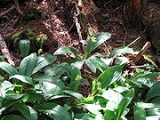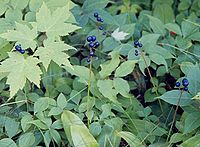
Blue-bead lily
Encyclopedia
Clintonia borealis is a perennial forest plant found in eastern North America
. It was once classified within the genus Convallaria
.

s, usually found in homogeneous colonies. At full growth, a shoot has 2–4 clasping and curved, slightly succulent leaves with parallel venation. The flowers are arranged in small umbel
s at the extremity of a long stalk. They have 6 stamen
s and 3 identical sepal
s and petal
s (tepal
s). In rare cases more than one umbel is found on a shoot or shoots from a clone. The fruits are small dark blue, lurid berries. A white-berried form (f. albicarpa) also exists.
The plant reproduces via seed or vegetatively by rhizomes. Flowering in May and June, it takes over a dozen years for a clone to establish and produce its first flower, 2 years of which are dedicated solely to germination. The rhizome starts to mold after approximatively 15 years, but a colony often covers several hundred m². Few specimens establish new colonies.
Like other slow-growing forest plants, such as Trillium
s, Blue-bead lily is extremely sensitive to grazing by White-tailed Deer
.
, a saponin
steroid
with estrogen
ic effects.
According to a Mi'kmaq tale, when a grass snake
eats a poisonous toad
, it slithers in rapid circles around a shoot of blue-bead lily to transfer the poison to the plant.
North America
North America is a continent wholly within the Northern Hemisphere and almost wholly within the Western Hemisphere. It is also considered a northern subcontinent of the Americas...
. It was once classified within the genus Convallaria
Convallaria
Convallaria majalis , commonly known as the lily-of-the-valley, is a poisonous woodland flowering plant native throughout the cool temperate Northern Hemisphere in Asia and Europe....
.

Botanical properties
Blue-bead lilies are small (5–10 in) perennial plantPerennial plant
A perennial plant or simply perennial is a plant that lives for more than two years. The term is often used to differentiate a plant from shorter lived annuals and biennials. The term is sometimes misused by commercial gardeners or horticulturalists to describe only herbaceous perennials...
s, usually found in homogeneous colonies. At full growth, a shoot has 2–4 clasping and curved, slightly succulent leaves with parallel venation. The flowers are arranged in small umbel
Umbel
An umbel is an inflorescence which consists of a number of short flower stalks which are equal in length and spread from a common point, somewhat like umbrella ribs....
s at the extremity of a long stalk. They have 6 stamen
Stamen
The stamen is the pollen producing reproductive organ of a flower...
s and 3 identical sepal
Sepal
A sepal is a part of the flower of angiosperms . Collectively the sepals form the calyx, which is the outermost whorl of parts that form a flower. Usually green, sepals have the typical function of protecting the petals when the flower is in bud...
s and petal
Petal
Petals are modified leaves that surround the reproductive parts of flowers. They often are brightly colored or unusually shaped to attract pollinators. Together, all of the petals of a flower are called a corolla. Petals are usually accompanied by another set of special leaves called sepals lying...
s (tepal
Tepal
Tepals are elements of the perianth, or outer part of a flower, which include the petals or sepals. The term tepal is more often applied specifically when all segments of the perianth are of similar shape and color, or undifferentiated, which is called perigone...
s). In rare cases more than one umbel is found on a shoot or shoots from a clone. The fruits are small dark blue, lurid berries. A white-berried form (f. albicarpa) also exists.
Distribution and multiplication
The plant is native to the boreal forest in eastern North America, but is also found in other coniferous or mixed forests and in cool temperate maple forests. It is not found in open spaces, and only grows in the shade.The plant reproduces via seed or vegetatively by rhizomes. Flowering in May and June, it takes over a dozen years for a clone to establish and produce its first flower, 2 years of which are dedicated solely to germination. The rhizome starts to mold after approximatively 15 years, but a colony often covers several hundred m². Few specimens establish new colonies.
Ecological aspects
Blue-bead lily is extremely slow to spread, but established clones can usually survive many later modifications, as long as sunlight remains limited. Whereas crossed pollination is more efficient in producing seeds, self-pollination will still produce seeds, allowing the plant to propagate.Like other slow-growing forest plants, such as Trillium
Trillium
Trillium is a genus of about 40–50 species of spring ephemeral perennials, native to temperate regions of North America and Asia....
s, Blue-bead lily is extremely sensitive to grazing by White-tailed Deer
White-tailed Deer
The white-tailed deer , also known as the Virginia deer or simply as the whitetail, is a medium-sized deer native to the United States , Canada, Mexico, Central America, and South America as far south as Peru...
.
Medicine
The rhizome contains diosgeninDiosgenin
Diosgenin, a steroid sapogenin, is the product of hydrolysis by acids, strong bases, or enzymes of saponins, extracted from the tubers of Dioscorea wild yam, such as the Kokoro...
, a saponin
Saponin
Saponins are a class of chemical compounds, one of many secondary metabolites found in natural sources, with saponins found in particular abundance in various plant species...
steroid
Steroid
A steroid is a type of organic compound that contains a characteristic arrangement of four cycloalkane rings that are joined to each other. Examples of steroids include the dietary fat cholesterol, the sex hormones estradiol and testosterone, and the anti-inflammatory drug dexamethasone.The core...
with estrogen
Estrogen
Estrogens , oestrogens , or œstrogens, are a group of compounds named for their importance in the estrous cycle of humans and other animals. They are the primary female sex hormones. Natural estrogens are steroid hormones, while some synthetic ones are non-steroidal...
ic effects.
Food
The young leaves of the plant are edible while still only a few inches tall. The fruit however, is mildly toxic, and is quite unpleasant tasting.Cultivation
Culture is difficult, due to the need to avoid direct sunlight and the difficulty posed by germination. Transplanting is not recommended.Trivia
Hunters in North Quebec were said to have rubbed their traps with the roots because bears are attracted to its odor.According to a Mi'kmaq tale, when a grass snake
Grass Snake
The grass snake , sometimes called the ringed snake or water snake is a European non-venomous snake. It is often found near water and feeds almost exclusively on amphibians.-Etymology:...
eats a poisonous toad
Toad
A toad is any of a number of species of amphibians in the order Anura characterized by dry, leathery skin , short legs, and snoat-like parotoid glands...
, it slithers in rapid circles around a shoot of blue-bead lily to transfer the poison to the plant.

